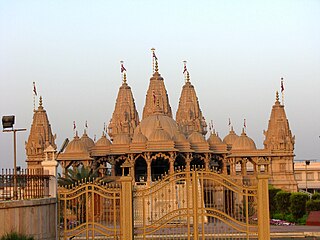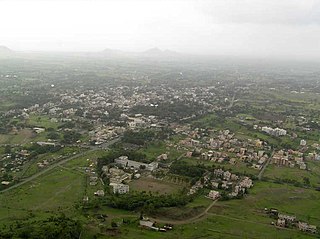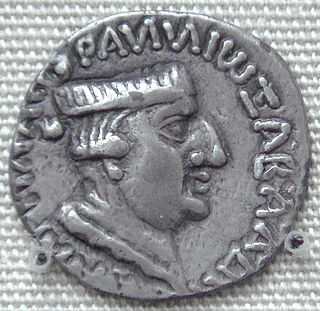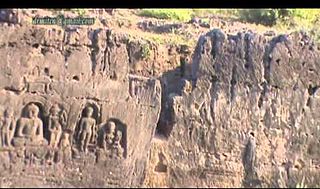
Bharuch, formerly known as Broach, is a city at the mouth of the river Narmada in Gujarat in western India. Bharuch is the administrative headquarters of Bharuch District.

Junnar is a city in the Pune district of the Indian state of Maharashtra. The city has history dating back to the first millennium. The nearby fort of Shivneri was the birthplace of Maratha king Chatrapati Shivaji Maharaj, the founder of the Maratha Empire. Junnar was declared the first tourism taluka in Pune district by the government of Maharashtra on 9 January 2018.

Nahapana, was an important ruler of the Western Kshatrapas, descendant of the Indo-Scythians, in northwestern India, who ruled during the 1st or 2nd century CE. According to one of his coins, he was the son of Bhumaka.

Taranga is a Jain pilgrimage center near Kheralu in Mehsana district, Gujarat, India, with two compounds of Jain temples that are important examples of the Māru-Gurjara style of architecture. The Ajitnatha temple, was constructed in 1161 by the Chaulukya king Kumarapala, under the advice of his teacher, Acharya Hemachandra. Both the main sects of Jainism are represented, with adjoining walled compounds: the Svetambara compound consists of 14 temples in all, and there are also five Digambara-affiliated temples at Taranga hill.

The Undavalli Caves, a monolithic example of Indian rock-cut architecture and one of the finest testimonials to ancient viswakarma sthapathis, are located in Mangalagiri Tadepalle Municipal Corporation of Guntur district in the Indian state of Andhra Pradesh. The caves are located 6 km south west from Vijayawada, 22 km north east of Guntur City of Andhra Pradesh. It is one of the centrally protected monuments of national importance.

Indian rock-cut architecture is more various and found in greater abundance in that country than any other form of rock-cut architecture around the world. Rock-cut architecture is the practice of creating a structure by carving it out of solid natural rock. Rock that is not part of the structure is removed until the only rock left makes up the architectural elements of the excavated interior. Indian rock-cut architecture is mostly religious in nature.

South Gujarat, also known as Dakshin Gujarat, is a region in the Indian state of Gujarat. The region has a wetter climate than other regions of Gujarat. The western part is almost coastal and is known as Kantha Vistar, and the eastern part is also known as Dungar Vistar, which ranges from 100 to 1000 metres, with the highest peak at Saputara in the Dang district.

The Diu Fortress is a Portuguese-built fortification located on the west coast of India in Diu. The fortress was built as part of Portuguese India's defensive fortifications at the eastern tip of the island of Diu during the 16th century. The fortress, which borders on the town of Diu, was built in 1535 subsequent to a defense alliance forged by Bahadur Shah, the Sultan of Gujarat and the Portuguese when Humayun, the Mughal Emperor attempted to annex this territory. It was strengthened over the years, till 1546. The Portuguese ruled over this territory from 1537 until the Indian invasion of December 1961. Today it is a landmark of Diu and one of the Seven Wonders of Portuguese Origin in the World.
Kutch Gurjar Kshatriya are a minority Hindu and one of the Socially and Educationally Backward communities of Gujarat in India, who claim to be Kshatriyas. They are an artisan community related with Kadia works. They are also known as the Mistri or Mistris of Kutch.

Varaha Cave Temple is a rock-cut cave temple located at Mamallapuram, on the Coromandel Coast of the Bay of Bengal in Kancheepuram District in Tamil Nadu, India. It is part of the hill top village, which is 4 kilometres (2.5 mi) to the north of the main Mahabalipurm sites of rathas and the Shore Temple. It is an example of Indian rock-cut architecture dating from the late 7th century. The temple is one of the finest testimonial to the ancient Hindu rock-cut cave architecture, out of many such caves also called mandapas. Part of the Group of Monuments at Mahabalipuram, the temple is a UNESCO World Heritage Site as inscribed in 1984 under criteria i, ii, iii and iv. The most prominent sculpture in the cave is that of the Hindu god Vishnu in the incarnated form of a Varaha or boar lifting Bhudevi, the mother earth goddess from the sea. Also carved are many mythical figures.

Junagadh Buddhist Cave Groups are located in Junagadh district of the Indian state of Gujarat. These caves group includes Uparkot Caves, Khapra Kodiya Caves and Baba Pyare Caves. The so-called "Buddhist Caves" are not actually caves, but three separate sites of rooms carved out of stone to be used as monks' quarters. These caves were carved starting from Emperor Ashoka's period up to 1st–4th century AD.

The Dhank Caves are located near Dhank village near Upleta, Rajkot district, Gujarat, India. They were chiseled out of a calcareous sandstone outcropping during the regime of the Western Satraps. The caves are influenced by Buddhist and Jain cultures. The Jain cave includes figures of Adinath, Shantinath and Pārśva. These are considered to be the earliest Jain sculptures in Kathiawad.

The Talaja Caves are located in Bhavnagar district of the Indian state of Gujarat at Talaja. The rock cuts are carved out into deserted conical rocks. The rock cut group include 30 caves among which about 15 are water tanks. The cave has unique architecture known as Ebhal Mandapa. The halls are plain. "On the facade there are chaitya windows with a broad bank below them." The chaitya and cells were carved during Buddhism influence in 2nd century BC.

There are two sets of Buddhist caves in two different places taking the name of Shana caves.

Khambhalida Caves, are three Buddhist caves located in Jetpur in Gujarat, India.
The Siyot Caves, sometimes referred to as the Kateshwar Buddhist Caves, are five rock-cut caves located near Siyot village in the Lakpat Taluka of Kutch district, Gujarat, India. The caves are believed to belong to the first century AD.

The Lomas Rishi Cave, also called the Grotto of Lomas Rishi, is one of the man-made Barabar Caves in the Barabar and Nagarjuni hills of Jehanabad district in the Indian state of Bihar. This rock-cut cave was carved out as a sanctuary. It was built during the Ashokan period of the Maurya Empire in the 3rd century BC, as part of the sacred architecture of the Ajivikas, an ancient religious and philosophical group of India that competed with Jainism and became extinct over time. Ājīvikas were atheists and rejected the authority of the Vedas as well as Buddhist ideas. They were ascetic communities and meditated in the Barabar caves. Still, the Lomas Rishi cave lacks an explicit epigraphical dedication to the Ajivikas, contrary to most other Barabar Caves, and may rather have been built by Ashoka for the Buddhists.

Uparkot caves, also Uperkot caves, are ancient man-made caverns. The caves are a part of the Junagadh Buddhist Cave Groups situated in the eastern part of Junagadh of the Indian state of Gujarat.

The Khapra Kodiya Caves are part of the Junagadh Buddhist Cave Group. They are the oldest of the caves in the group. The caves, on the basis of scribbles and short cursive letters on the wall, are dated to 3rd-4th century BCE during the Emperor Ashoka's rule and are the plainest of all the caves in the groups. These caves are also known as Khangar Mahal. They were carved in rock during the reign of Emperor Ashoka and are considered the earliest monastic settlement in the area. These caves are along the edge of the ancient Sudarshan Lake and a little outside Uparkot fort, to the north.
























